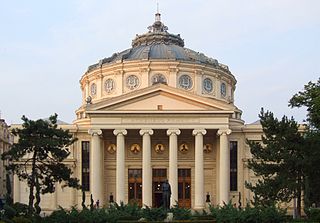
Bucharest is the capital and largest city of Romania. It is described as the cultural, financial, entertainment, and media center in the country with a significant influence in Eastern and Southeastern Europe as well. In geopolitical regards, Bucharest has been and still is an important capital of a state situated in Central and Eastern Europe, where noteworthy summits had taken place. It is also a city with a significant influence in terms of education, tourism, research, technology, health care, art, fashion, sports, and politics. Bucharest is a major economic center in Romania, with a diverse and growing economy that includes industries such as IT, finance, and manufacturing. The city has also seen significant investment in infrastructure, with new roads, bridges, and public transportation systems being built to improve connectivity and mobility. It is located in the south-east of Romania, on the banks of the Dâmbovița river, less than 60 km (37.3 mi) north of the Danube River and the border with Bulgaria. It is also one of the most populated cities of the European Union (EU) within city limits and the most populated capital in Southeastern Europe. It was the capital of Wallachia from 1659 to 1859 and the capital of the United Principalities of Moldavia and Wallachia from 1859 to 1881.
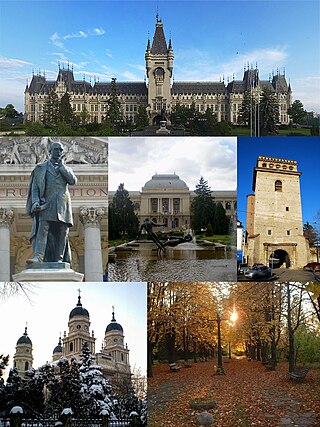
Iași, also referred to mostly historically as Jassy, is the third largest city in Romania and the seat of Iași County. Located in the historical region of Moldavia, it has traditionally been one of the leading centres of Romanian social, cultural, academic and artistic life. The city was the capital of the Principality of Moldavia from 1564 to 1859, then of the United Principalities from 1859 to 1862, and the capital of Romania from 1916 to 1918.
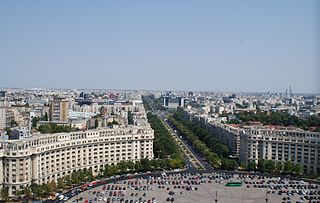
Centrul Civic is a district in central Bucharest, Romania, which was completely rebuilt in the 1980s as part of the scheme of systematization under the dictator Nicolae Ceaușescu, which included the construction of new civic centres in the Romanian cities. Bucharest Civic Centre was planned to become the new political-administrative center of Communist Romania.

The Romanian Orthodox Church, or Patriarchate of Romania, is an autocephalous Eastern Orthodox church in full communion with other Eastern Orthodox Christian churches, and one of the nine patriarchates in the Eastern Orthodox Church. Since 1925, the church's Primate bears the title of Patriarch. Its jurisdiction covers the territories of Romania and Moldova, with additional dioceses for Romanians living in nearby Serbia and Hungary, as well as for diaspora communities in Central and Western Europe, North America and Oceania. It is the only autocephalous church within Eastern Orthodoxy to have a Romance language for liturgical use.

The National Bank of Romania is the central bank of Romania and was established in April 1880. Its headquarters are located in the capital city of Bucharest.
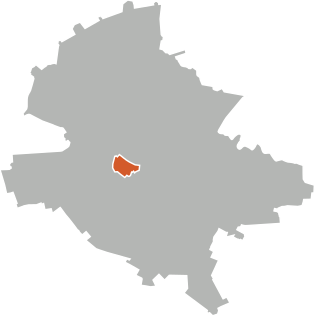
Cotroceni is a neighbourhood in western Bucharest, Romania located around the Cotroceni hill, in Bucharest's Sector 5.

Dumitru Stăniloae was a Romanian Orthodox Christian priest, theologian and professor. He worked for over 45 years on a comprehensive Romanian translation of the Greek Philokalia, a collection of writings on prayer by the Church Fathers, together with the hieromonk, Arsenie Boca, who brought manuscripts from Mount Athos. His book, The Dogmatic Orthodox Theology (1978), made him one of the best-known Christian theologians of the second half of the 20th century. He also produced commentaries on earlier Christian thinkers, such as St Gregory of Nyssa, Saint Maximus the Confessor, and St Athanasius of Alexandria. He is also remembered as editor in chief of the regional orthodox newspaper Telegraful Român (1934–1945) where he imposed a nationalist and antisemitic editorial line.
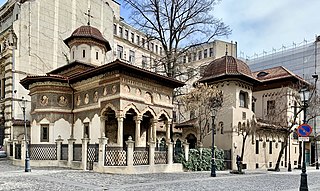
Stavropoleos Monastery, also known as Stavropoleos Church during the last century when the monastery was dissolved, is an Eastern Orthodox monastery for nuns in central Bucharest, Romania. Its church is built in Brâncovenesc style. The patrons of the church are St. Archangels Michael and Gabriel. The name Stavropoleos is the genitive case of Stavropolis. One of the monastery's constant interests is Byzantine music, expressed through its choir and the largest collection of Byzantine music books in Romania.

Visarion Puiu was a metropolitan bishop of the Romanian Orthodox Church. During World War II, at a time when Romania was an ally of Nazi Germany, he served as the leading Eastern Orthodox clergyman in occupied Transnistria, a territory where several hundred thousand Jews were murdered. In August 1944, when Romania switched sides, he took refuge in Nazi Germany.
The Carol Parc Hotel in Bucharest, Romania, is a five star hotel near historical Carol Park. Opened in 2007, it contains one of the largest Murano crystal chandeliers in the world, stretching over four stories tall. Several celebrities have stayed there, including foreign dignitaries, singer Beyoncé Knowles, Deep Purple, Angela Gheorghiu, and Enrique Iglesias.

Dorobanți is a neighborhood in Sector 1, Bucharest. The neighborhood is dominated by red brick buildings and glass buildings. Main intersections/squares are Perla, Dorobanți Square, Alexandru Lahovari Square, Charles de Gaulle Square, and Quito Square. Main streets are Calea Dorobanților, Iancu de Hunedoara Avenue, Lascăr Catargiu Boulevard, and a small part of Ștefan cel Mare Boulevard. The district features many embassy buildings, and local cafés are regarded as meeting places of Bucharest's nouveau riche.

The Palace of the Chamber of Deputies is a building in Bucharest, Romania located on the plateau of Dealul Mitropoliei. The building served as the seat of successive Romanian legislatures: of the Assembly of Deputies during the Kingdom of Romania, then of the Communist-era Great National Assembly, and after the Romanian Revolution of 1989, of the Chamber of Deputies. Parliamentarians vacated the building in 1997, when it passed to the Patriarchate of the Romanian Orthodox Church.

The Anglican Church of the Resurrection is a church located in central Bucharest, Romania, near Grădina Icoanei, at the intersection of Xenopol street and Arthur Verona street. The church is a red brick building and services are held in English on Sundays between 10 and 11 AM.

The Cuibul cu barză Church dedicated to the Saint Stephen is a Romanian Orthodox church located on Știrbei Vodă Street in Bucharest's Sector 1. As mentioned on the inscription, placed after the 1898 rehabilitation, at the entrance of the church the name is due to the nests which storks had built on the building's shingle roof.

The relationship between the Romanian Orthodox Church and the Iron Guard was one of ambivalence. The Romanian Orthodox Church promoted its own version of nationalism which highlighted the role of Orthodoxy in preserving the Romanian identity. Starting with the 1920s, the Church became entangled with fascist politics and antisemitism. In this context, the Iron Guard, also known as the Legion of the Archangel Michael, a fascist movement founded in 1927, became very influential with church grassroots. Numerous rank-and-file priests joined the Iron Guard ranks and actively supported its policies; so did a minority of influential high-ranking clergymen such as Nicolae Bălan or Vartolomeu Stănescu.
The following is a timeline of the history of the city of Bucharest, Romania.

The Sfinții Voievozi Monastery is a monastery in Slobozia, Ialomița County, Romania. It dates to the 17th century.

Saint Basil the Great Cathedral, located at 50 Polonă street, is the first Romanian Greek-Catholic church built in Bucharest. The church's patron is Basil of Caesarea and its dedication celebration is on January 1.
Cristofi Cerchez was a Romanian engineer and architect. He built approximately 50 buildings in various cities of Romania over his nearly 50-year career. His architecture covers a wide range of styles from traditional to eclectic to modern, as well as private, civic and religious edifices. Among the buildings he worked on were the Bucharest Palace of Justice, the State Archives wing of the Mihai Vodă Monastery, the monastery of Vălenii de Munte, and the Nicolae Minovici Folk Art Museum.
A pisanie is an architectural elements, that consists of an inscription carved in stone, wood, metal, painted, etc., on the top of tombs or above the main door at the entrance in a church, in which are recorded information about the church, the donator, the founder, the builder, the data when the church was built etc. The inscription usually includes a religious invocation, the name of the founder or founders, the date of construction, the motivation of the building, the circumstances of the time and other data.
























